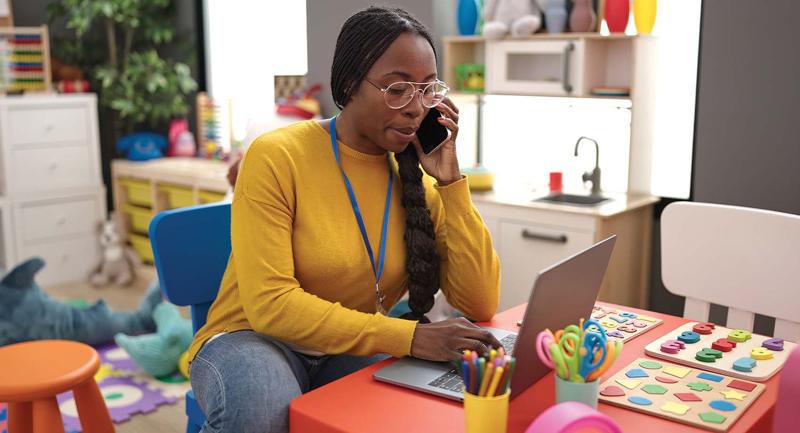In our digital age, finding accurate information online can feel like a Herculean task for educators and students. Media outlets, social media, artificial intelligence, and search engines create a maze of advertisements and promotions, deep fakes, political propaganda, false claims, and other suspect content that easily overwhelms students when they try to do research or find credible sources.
This challenge is particularly complex when diving into civic engagement issues (local elections, voting, education, activism, etc.), which are often politicized in local communities and can carry with them a lot of misinformation. High-quality civics education can and should teach students the importance of taking civic action and determining shared values in a community. But it also must promote critical thinking and democratic decision-making using credible sources.
Civics Isn’t Political
There is a prevailing misconception that civics class is all about politics. We need to dispel this myth. While politics is about policy, civics is about engagement, regardless of policy. Civics is not about fostering political agendas, but about cultivating individuals who actively engage in their communities. To mitigate the belief that civics is purely political, we need to frame civic learning around shared issues and values, learning multiple perspectives, and promoting diverse solutions, while still attending to bias and facts (Barton & Ho, 2023).
In our current climate, many citizens dismiss sources as biased or quickly lump a news story with a political party or agenda. While this might be true in some cases, good research and information may be discarded in the process. We need to prepare students to carefully analyze and evaluate sources and not rush to judgment. We need to teach “slow response to fast media” (Krutka, 2024).
The College, Career, and Civic Life (C3) Framework, from the National Council for the Social Studies, explicitly calls attention to the importance of sourcing (NCSS, 2013). Dimension 3 identifies gathering and evaluating sources, developing claims, and using evidence as key skills students need to learn. For example, by the end of Grade 12, students should be able to “identify evidence that draws information directly and substantively from multiple sources to detect inconsistencies in evidence in order to revise or strengthen claims.”
Civics is not about fostering political agendas, but about cultivating individuals who actively engage in their communities.
Emphasizing digital citizenship skills and critical thinking within civics education strengthens students’ ability to fully understand complex issues across multiple content areas. Students can engage in civic action, for instance, to address environmental issues at a local watershed. This can not only help them understand the interconnections and interdependency of ecological systems, but also build habits to make personal and collective choices to promote sustainability. Similarly, a lesson on free speech rights in schools can be an opportunity for students to research different arguments for and against an issue and then develop persuasive writing skills to craft policy recommendations for their school and district.
There are many creative opportunities for educators to design meaningful learning experiences aligned to the passions and interests of their students and community, all while teaching students how to become informed citizens who understand where information is coming from and how to interpret it.
Supporting Core Digital Skills
Students can learn from how professional fact-checkers in newsrooms or academia evaluate sources (McGrew & Breakstone, 2023). Skilled fact-checkers, for example, “read laterally.” This involves slowing down their review of information presented to them, investigating the source more deeply, and considering other sources on the topic. Here are several key digital skills that educators can teach students as they research information.
Exercise Click Restraint
Often when we type in keywords to search online, our instinct is to click on the first result on the page. However, a better practice is to exercise “click restraint” and scan all the results to make a more informed choice, evaluating where the source comes from, who the author or organization is, and how closely aligned the information is to your research question.
A teacher can model this skill by talking through search results on a particular topic. She can show students how to analyze the list of links to determine the source or relevancy of the result and point out things like “promoted” or “sponsored” links that might have a particular agenda or be selling a product. By exercising click restraint, students will become better researchers and dig deeper to find more relevant and accurate information.
Evaluate a Source Thoroughly
The ability to evaluate a source is probably the most common digital skill teachers address in the classroom. When scanning social media, students find videos or short posts with someone making a claim and linking to an article. But how do students know if the article is reliable, credible, and accurate?
Educators should define the terms reliability and credibility and ask students to apply those terms to sources they find online. Sometimes a lot of work goes into making a source look attractive to draw readers’ attention. Educators can teach students to go beyond surface-level appearances of a well-designed site and ensure the source is truly valid. They can also help students evaluate the evidence, or lack thereof, that sources use to make their claims.
Consider Other Sources
By finding multiple sources on a research topic and considering different approaches and opinions, students develop a more complex and nuanced view of the topic. Educators can model this skill by analyzing multiple sources and comparing them for differences and similarities. They can ask students to evaluate the strength of the evidence that sources cite and to consider counterclaims to get a more robust look at the research topic.
Note the critical role that educators take in teaching these skills. Research shows the importance of “cognitive apprenticeship,” where educators demonstrate expert thinking to novice learners and provide appropriate scaffolding (McGrew & Breakstone, 2023). Educators should focus on one skill at a time to ensure maximum retention and learning. The Digital Inquiry Group (formally Stanford History Education Group) has many resources and lessons available to educators on their website “Civic Online Reasoning” that target these specific skills. Civics and Digital Sourcing
To help guide teachers to connect civics education issues to effective digital sourcing, I created a lesson structure flow (see fig. 1). This lesson structure focuses on a civic challenge, highlights instruction of a specific digital skill, and offers opportunities for student collaboration, voice, and choice.
Let’s look at how this lesson structure might work in practice. A middle school social science teacher who we’ll call Ms. Terry wanted to center a lesson on a civics topic that her students were interested and invested in. Talking to them, she realized that many were concerned about how the COVID-19 pandemic affected school attendance and changed their feelings about coming to school sick, even several years after the pandemic ended. The students had lingering concerns around safety, wearing masks, and policies surrounding when to stay home because of illness.
Ms. Terry wanted to help her students feel safer while also giving them an opportunity to address a challenge that had civic implications. Initially, she thought she might pose a question for debate: Should we keep COVID-19 policies in place? But because she wanted students to have a more nuanced look at the issue, she crafted a question that would build a sense of community and shared values (Barton & Ho, 2023). She decided on: How can we help our fellow students be safe, healthy, and happy?
Her first step was to have the students generate ideas on how to keep fellow students safe and healthy. Students shared many ideas, including wearing masks when sick or uncomfortable, requiring vaccines for all students, providing medicine to students, and requiring students to stay home when they were ill. Ms. Terry had students work in teams to think through the intended and unintended consequences of the ideas mentioned and take “wise” action—action supported by evidence and carefully vetted, not just action based on opinions or first ideas (Barton & Ho, 2022).
Next, she chose a digital literacy skill to focus on. Because her students tended to quickly click on the first result that showed up on a search engine when they were doing research, she decided to emphasize “click restraint.” She connected with her science colleagues, and they experimented with different search terms such as “mask mandates” and “germ protection in school,” which gave her varied examples to model click restraint with her students. For instance, when searching for “mask mandates,” the initial result that came up was an advertisement sponsored by a healthcare company trying to sell a mask, while below that was information from schools, government, and other healthcare authorities. Ms. Terry and her students discussed this example, how they might resist clicking on the first result, and why. The teacher also noticed students were clicking on “sponsored results” if the title included the word “news,” and so they discussed what a sponsored result might be and how even sources that included reputable-sounding words such as “news” might have to be examined further for bias or validity.
By exercising click restraint, students will become better researchers and dig deeper to find more relevant and accurate information.
Ms. Terry asked her students to complete a reflection on what they learned and list two resources they found effective. At the conclusion of the lesson, Ms. Terry determined that students had not only learned a lot about “click restraint,” but had also demonstrated civic deliberation skills on a topic that was meaningful to them. Instead of simple “yes” or “no” answers, students had recommendations that were varied and based in context and vetted evidence. Students even wrote counterclaims to the sources they first found when they did not engage in “click restraint” and were able to collaborate with their peers on recommendations that drew on multiple perspectives on the issue. The class showed a continued interest in school policy and health and wanted to look at other topics related to health in the community. Ms. Terry decided to plan a lesson focused on evaluating sources to reinforce the concepts they had learned.
Our Call to Action
As educators, we have a call to not only create civically engaged citizens but also citizens that can effectively evaluate the constant stream of information they encounter and make informed decisions. By focusing on digital skills that support lateral reading and grounding these skills in meaningful civic contexts, we can create engaging classrooms where students take informed action supported by critical thinking and evidence.









